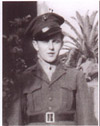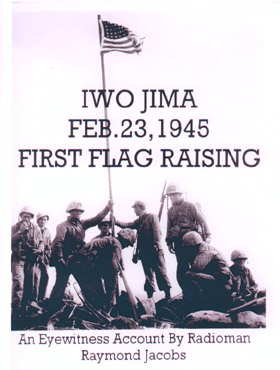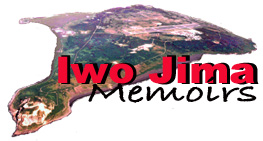

Raymond Jacobs
F
Company Radioman, 2nd Battalion, 28th Marines,
5th Marine Division (Iwo Jima)
Pacific Campaign: Iwo Jima
United States Marine Corps
Active Service: 1943 - 1946
Inactive Reserves: 1946-1950
Recalled: 1950-1951
On February
22, 2004, we at World War II Stories --
In Their Own Words received a brief message
via our e-mail from a Mr. Raymond Jacobs. Mr. Jacobs offered
to forward to us a copy of an essay that he had just
completed regarding events that occured on February 23, 1945
atop Mt. Suribachi on the island of Iwo Jima.
The event
mentioned in this essay is the historic
1st Flag Raising. Even though
this event was overshadowed by the famous 2nd Flag Raising
that caught worldwide attention when Mr. Joe Rosenthal
caught this moment in time on film, recognition for the
original flag raising was slow to come.
To this day,
Mr. Raymond Jacobs insists that his presence on the patrol
that walked, climbed, and crawled up Mt. Suribachi during
the intense first few days of battle for the "black pearl of
the Pacific" has yet to be recognized.
Why?
We recently
received a copy of a document sent to Mr. Jacobs from the
firm of Ebert & Associates Inc. who examined the
photographic evidence presented by Mr. Jacobs.
The findings
are below in the attached letter.
the
Webmaster
EBERT & ASSOCIATES INC.
3700 RIO GRANDE BLVD. N.W., SUITE
3
ALBUQUERQUE, NEW MEXICO
87107-3042
(505) 344-2345
Facsimile (505) 344-2444
e-mail: jebert@ebert.com
Website: www.ebert.com
August 9, 2004
Raymond Jacobs
(Address)
Dear Ray:
Thank you for trusting me with your
photographs, which I have spent some time analyzing. As you
know, I am a forensic photogrammetrist and have considerable
experience in making and evaluating identifications of
individuals depicted in photographs, video, and other sorts
of images. In making comparisons of individuals in such
images, I use digital image processing to optimize the
visibility of facial and other details, to examine them
closely, and sometimes also use digital imaging and mapping
techniques to make comparative measurements.
When you first sent me copies of the
photographs taken by Sgt. Lou Lowery on February 23, 1945 at
the first flag raising atop Mt. Suribachi on Iwo Jima, and
other photographs of you taken at various times, I explained
to you in some detail my professional "philosophy" regarding
the identification of individuals in photographs.
Identifications and comparisons of individuals depicted in
images are sometimes difficult or impossible for a number of
reasons. Many different people look very much the same, and
conversely, a single "known" individual can look quite
different in photographs taken even a short time apart.
Differences in the resolution and the conditions under which
photographs were taken often make comparisons difficult too,
and in my experience high quality, original negatives or
photo prints, especially for older photos, are almost never
available.
When I make comparisons of individuals in
photographs and other images, I always look first for
"unique" identifying patterns, such things as patterns of
freckles or moles, distinctive scars, broken or crooked
teeth, or other things that would be exceedingly unlikely to
occur in two separate individuals. I did not find any such
unique patterns in the photographs you sent me. As you
suggested to me, the young Ray Jacobs didn't have any such
facial "defects," but even if he had they might very well
have been undetectable because of the quality and resolution
of the photographs, particularly the Lowery photographs you
obtained from Leatherneck Magazine, which upon close
inspection I have concluded are some sort of photomechanical
or at least multi-generational photo copies.
Given images like that, what I would do to
illustrate that the radioman on Mt. Suribachi in the Lowery
pictures is you would be just what you already did in your
"Eyewitness Account" book: to scale and juxtapose comparable
photos known to be you next to the Lowery pictures and note
the similarities. And the similarities between the "known"
Ray Jacobs in the photos you sent me, and the radioman in
Lowery's Mt. Suribachi photos, are striking.
Just as important, however, is the lack of
dissimilarities, which brings me to the culmination of my
professional philosophy regarding identifications of
individuals from photographs. First, I do not think any
suggestion of a "positive identification" can or should be
made based on any single type of physical evidence, be it
photographic comparisons, fingerprints, bite marks, or
whatever, particularly in any legal case. In cases such as
the identification of Ray Jacobs as the radioman on Mt.
Suribachi, however, a second line of reasoning is, I think,
more germane: whether, given the physical evidence that is
available &endash; i.e. the photographs &endash; there is
any reason to believe that the radioman is not Ray
Jacobs.
And based on the photographic evidence I
have seen, there isn't. One way to state my conclusion is
that if I were given the photos you sent, and the Lowery
photos, and asked to try to illustrate that the radioman was
not Ray Jacobs, I could not do so. Another way to state this
conclusion is that, based on my experience in the
identification of individuals in photographs, and on my
examination of the photos you sent that we know are you,
when I look at the radioman in the Lowery photographs I am
looking at Ray Jacobs.
I
also need to comment here in regard to the Lowery photo of
the radioman from behind, looking out to sea, and the
markings on his canteen cover. Given the data I have, a
chemical photo print sent to me by Colonel Dave E.
Severance, USMC (Ret), and a digital version of the same
image sent by Colonel W. G. Ford, USMC (Ret), the editor of
Leatherneck Magazine, I can easily conclude that the
radioman is the same individual as that depicted in the
other Lowery photos, but I cannot decipher the name on the
canteen cover. When one can't unambiguously read printing or
writing in a photo, image processing techniques will not
"magically" recover details that aren't inherent in the
image. In such a case everyone, including me, is reduced to
simply guessing. And when I do this, I see what looks to me
like seven characters, spelling out something like
"Cachall," or "Gachall," or perhaps "Gabrial."
In
a number of past forensic cases in which objects or details
were just too "fuzzy" in a photograph to allow unambiguous
identification, I have used an essentially reverse technique
of making an image of an exemplar object and intentionally
blurring and otherwise distorting the image of the exemplar
to make it comparable to the fuzzy image. If the printing on
the radioman's canteen cover were stencilled and the same
kind of stencil could be located, such a reverse imaging
technique might be used to further contentions of what the
printing said. Based on the photographic data I have
examined, however, it wouldn't change my opinion that the
radioman shown in the Lowery photos taken on Mt. Suribachi
is Ray Jacobs.
Sincerely,
James I. Ebert, PhD
Certified Photogrammetrist
(ASPRS)
Fellow, American Academy of Forensic
Sciences
There are
many web sites devoted to the United States Marine Corps.
Below are some of the more interesting ones that give
accounts of the 5th Marine Division on Iwo
Jima:
Iwo
Jima (Flags of Our Fathers)
Gunny
G's Globe and Anchor - Sites &
Forums
5th
Marine Division on Iwo Jima
World
War II - Battle for Iwo Jima
Iwo
Jima Flag Raising on Mt. Suribachi
Original
story received in the mail on 12 March
2004.
Story
added and modified on 16 March 2004.
We, at the
World War II Stories - In Their Own
Words web site wish to offer to Mr. Raymond
Jacobs our most profound THANK YOU for the account of his
personal experiences -- during World War II and especially
for allowing us to share those memories. We will always be
grateful for this fine gentleman's contributions to the war
effort and to the countless other men and women who put
forth their "finest hour".
Note: To
view images taken by the web master of World War II Stories
-- In Their Own Words during his year on Iwo Jima, please
click on the following link to my World War II Stories Photo
Album:
WW
II Stories: Iwo Jima Photo Album
1965-1966
Did YOU serve on Iwo Jima?
Did you know
that there is a group of veterans who have gotten together
to form an association of servicemen, no matter what branch
of service, who served at one time or another starting at
the invasion of the island on February 19, 1945 and
continuing until the island was eventually returned to the
Japanese in 1968?
Iwo
Veterans Organization
Original
story received in the mail on 12 March
2004.
Story
added and modified on 16 March 2004.


